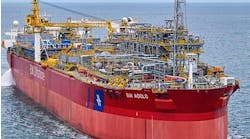While there has been talk for years about the drivers and the potential of subsea separations, never has the discussion been so widespread and intense. It is difficult to attend any industry gathering without this topic dominating the discussion. Various associated solutions are currently coming into vogue in what would appear to be anticipation that a solution is not too far away. In fairness, there are currently a number of pilot projects in the water and doing reasonably well. Initiatives, both government and private, are in place to support this game-changing technology.
Is it true that the industry has gone about as far as it can go with conventional systems. Is the time right for subsea separation, or is this a situation where the technology is in place and now the need for it must be justified?
No one can argue that the production of water is a major cost in deepwater development. The water takes up space in the flowlines and contributes to hydrate formation and slugging. It has to be drawn up the riser, processed on the platform, and then either reinjected or disposed. Removing even some of the water from the well stream would go a long way toward making many marginal fields economically viable. The production lines would be cleaner and more efficient, the topsides would be smaller, and there would be less need for expensive flow assurance chemicals and accordingly less environmental impact.
All of this sounds attractive, but the twin questions are how much will it cost and will it be reliable. If a system can be designed that efficiently removes water at the subsea wellhead and then either reinjects or diverts it, this system comes with a lot of necessary add-on equipment.
The efficiency of the separator has to be accurately measured. This means robust multi-phase meters. The produced water must either be pumped back downhole or up to a surface facility, and this requires a reliable multi-phase pump. In addition to metering, controls will be needed to ensure that the pumps and separators are working efficiently. If chemicals are needed, then this is another system that must be integrated. Forgetting for a moment the cost and complexity of such systems, the question of reliability has to be key. The price tag for these systems hardly matters if they don't work.
The only way a marginal subsea field can be economically produced is if it does not require intervention in the short term. Once something breaks down, then all the savings evaporate as a workover rig is moved on station and production is shut in. Further to this, if such a system was installed and the topsides sized to fit, then there's no going back. This is especially true in deepwater, where floating facilities can cost as much as $1/lb. A lighter, smaller processing system saves money up front, but cannot be easily swapped out for a larger, heavier conventional system if the subsea separator turns out not to work. Even if the floating facility were designed with excess capacity for future expansion, this would still eat up valuable deck space and impact the future expansion.
So why all the excitement about subsea separation?
Imagine a future where there are no offshore facilities at all. No semis, spars, TLPs, jackets, service vessels, or workboats. Everything is produced straight from the seabed to the shore. Operators on the beach can monitor and control production, processing, and flow assurance from their corporate offices, and no one but the drillers and explorers need go offshore.
It may never happen, and if it does, it is a long way off, but that is the vision: Taking expensive topsides out of the equation. It may never come to pass, but as more hub facilities are installed offshore, there will be a serious financial driver to tie back more subsea fields. The initial fields that feed these facilities are bound to play out, and when they do, they must be replaced. A subsea field that can deliver production with virtually no water will make a very attractive candidate for these hubs, and with the water being re-injected, will have a longer sustained field life.
William Furlow


